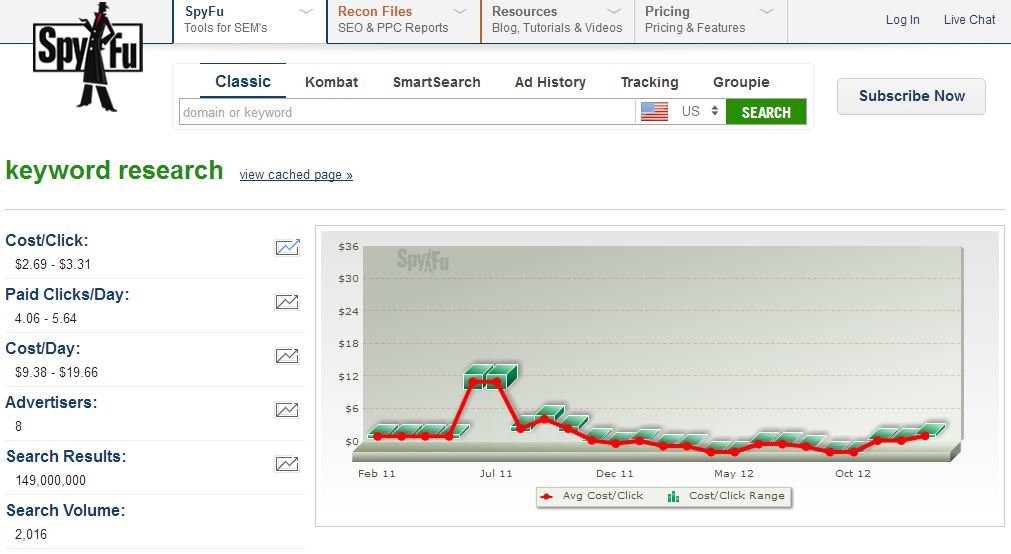
Keyword Spy – Is one of my favorites for getting a quick sense of the landscape. It very quickly (through use of tabs) gives you access to data on PPC ads, related keyword phrases, your paid and organic competitors, andmy favorite; misspellings! Did you know that keyword reserach has an estimated 110,000 searches per month! See a screenshot of the dashboard below(click to enlarge).
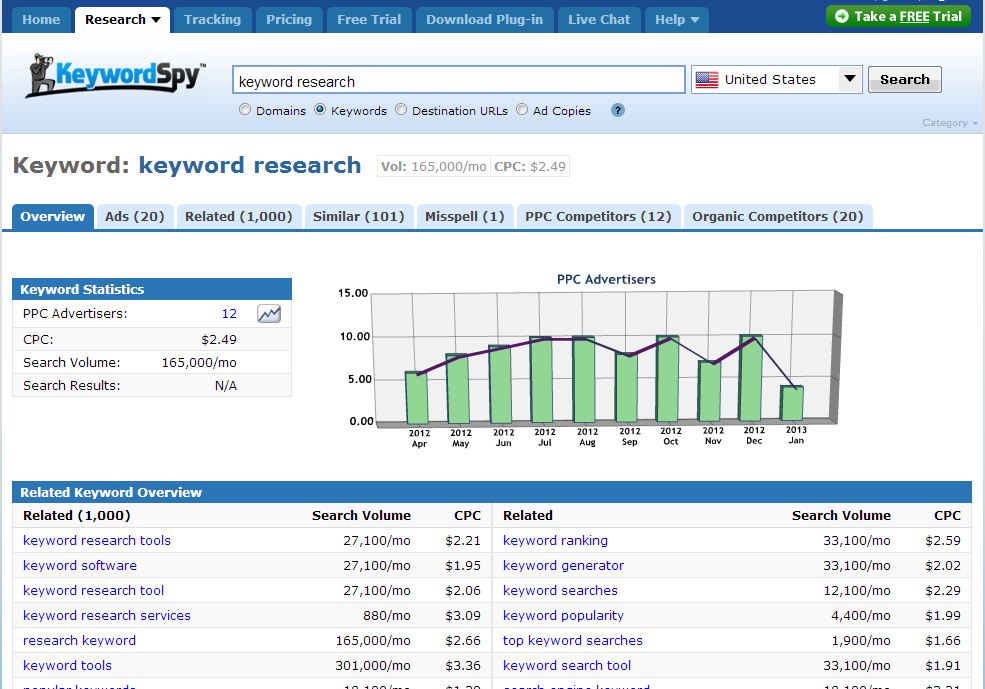
Validate The Big Opportunities
Once you have a good list going in Excel it’s important to gain visibility into your big opportunities, or as my team has come to talk call them; your golden tickets. First you will want to get a sense of seasonal volatility by running your top queries through Google Trends (click to enlarge):
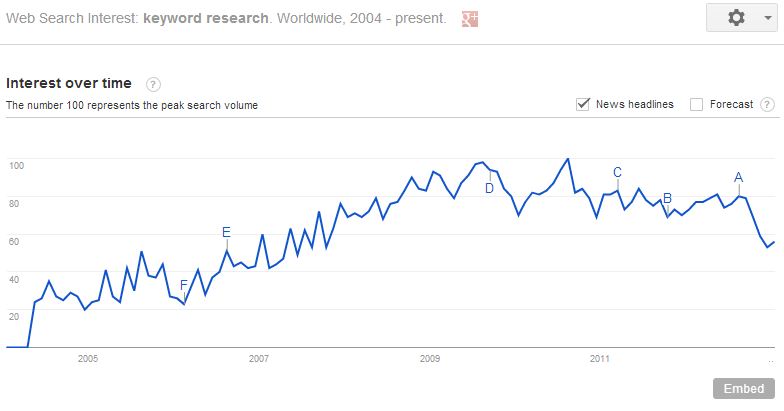
Pay attention to the average index of interest over time, since it can be a bit confusing; 100 here represents the highest search volume there has ever been, it is not the integer for number of searches. So what you are looking for is that the current interest has not fallen off completely, looking at the graph it seems the current search volume for keyword research is down about 50% from what it was in August 2010. Next you use a bit of a 3rd party litmus test to see how popular a topic really is, and a safe bet here is to use the worlds most popular encyclopedia, Wikipedia. Domas Mituzas has built a statistical engine that tracks Wikipedia’s pageviews. And looking at it over the past 90 days we can see that the term has been viewed 7,554 times (hat tip to Glen Allsopp for sharing this). Click to enlarge.
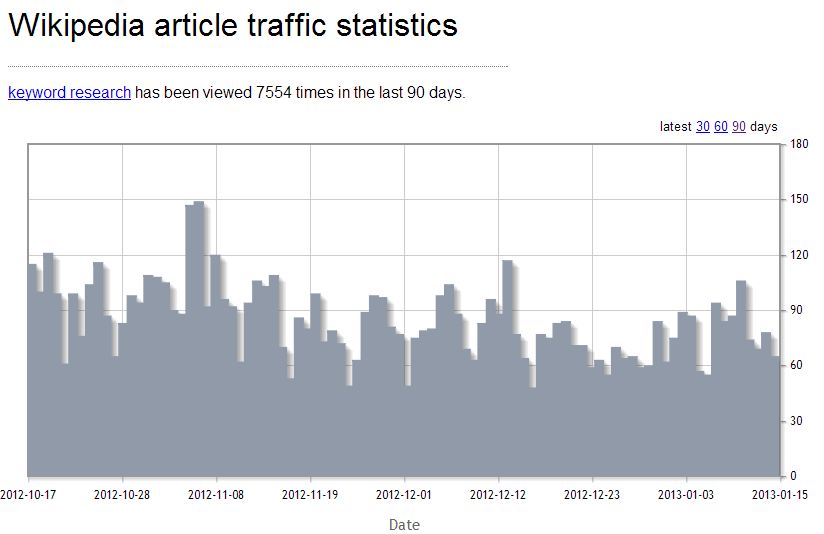
Creating a Keyword Evaluation Model
Evaluating keywords for relative opportunities is still very tough. Without massive stores of data and detailed insights into the competitive landscape it is easy to throw alot of time and money at targeting keywords that will never deliver a stable return. In order to avoid this and instead focus only where there is rank to be had and money to be made, I believe it’s best to use an evaluation method. There are a number of methodologies ranging from complex formulas including many different heuristics to more simplified models designed just to give you a sense of the opportunity. While I am working on a scaled-back version of my model to give away, it’s not quite ready yet – so for this post we are going to use a very simplified version. This is meant to be more of a barometer than anything else and this data should not be used to make a business case, but more so just to give you a sense of opportunity. I’m going to use keyword competitiveness scoring from SerpIQ, but you could also do this with SEOmoz’s keyword difficulty score or something similar. Scoring the opportunities takes some simple math. So for this version we are going to discount monthly search volume by multiplying is against the inverse discount rate of the competitive scores (1 minus the competitiveness index percentage). For this example I’m going to stick with our root phrase, keyword research, and use 2 other closely related variations:
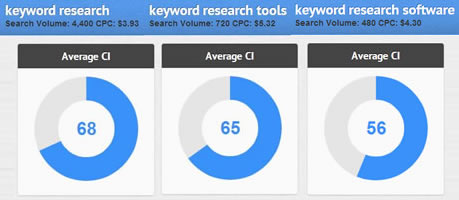
Using our quick and dirty evaluation model of (exact monthly search volume x (1 – CI%) we get:keyword research opportunity score (4,400 x (1-.68)) = 1,408 keyword research tools opportunity score (720 x (1-.65)) = 252 keyword research software opportunity score (480 x (1-.56)) = 211.2 Showing (quickly remember) that even though keyword research is significantly harder in terms of competition, it is still the clear winner in terms of keywords to target for search traffic. This is useful because it takes it takes into account the opportunities as related to monthly search volume and then discounts the traffic potential based on the average competition.
Closing the Loop
Part of doing successful keyword research is setting time aside each month to analyze what’s working, and adjust your content and link strategies accordingly. Where are you seeing the fastest movement in the SERP’s? Are some terms moving between the top 10/30/50 positions faster than others? Which keywords are the fastest to page 1? Fastest to the top 5? Ask yourself these questions and please share your thoughts with me in the comments below – let me know your hypotheses or better yet your
actual data; share your research and tell me what worked and what didn’t, I would love to chat with you.
作者:Nick 編譯自http://www.datatmt.com/archives/35920.html
文:199IT
注:相關網站建設技巧閱讀請移步到建站教程頻道。

